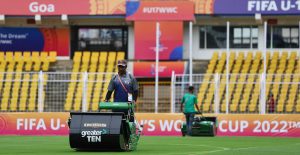 Having begun with sixteen teams, the 2022 FIFA U-17 Women’s World Cup in India has reached the semifinal stage with four teams remaining. The two semifinal fixtures which will determine the finalists, will be played in Goa’s Pandit Jawaharlal Nehru Stadium. The pitch at the stadium underwent a major makeover ahead of the tournament, and will be in focus for one last time.
Having begun with sixteen teams, the 2022 FIFA U-17 Women’s World Cup in India has reached the semifinal stage with four teams remaining. The two semifinal fixtures which will determine the finalists, will be played in Goa’s Pandit Jawaharlal Nehru Stadium. The pitch at the stadium underwent a major makeover ahead of the tournament, and will be in focus for one last time.
In a major decision taken by FIFA in the build-up to the 2022 FIFA U-17 Women’s World Cup in India, Goa’s’ Pandit Jawaharlal Nehru Stadium became the first Indian football stadium to have a hybrid pitch. Explaining what exactly a hybrid pitch means, FIFA Senior Pitch Management Manager Alan Ferguson said, “In the context of an international football pitch, a hybrid pitch refers to where a synthetic or other medium is added to a natural sand-soil profile to boost the stability. Under the hybrid umbrella, there are 10-12 different concepts which are internationally available, the top among them is pitch-stitching, which was implemeted at the Pandit Jawaharlal Nehru Stadium.”
Hybrid pitches have existed for close to three decades and become a norm in European football. Outside of Europe, though, they are still a fairly novel concept. Things are moving fast however, and Ferguson has spearheaded similar work in Japan, Costa Rica, and South America in recent years.
In India, when FIFA decided to develop a hybrid pitch for the 2022 FIFA U-17 Women’s World Cup in India, Goa, the venue that had to host 16 out of the 32 matches became the obvious choice. “Sixteen matches in such a short time would result in a lot of pitch wear and tear, no matter the age group,” said Ferguson. “Added to that, the tournament being held towards the end of monsoons meant that we had to do something to ensure the pitch remained in top condition throughout the tournament.”
In comparison to a natural pitch, a hybrid pitch is at least three times more stable. As a result, not only can more football be played on these pitches, but players can play more freely with less fear of injuries. According to Ferguson, the stability of Goa’s hybrid pitch is visible to even an untrained eye. He said, “You don’t have to be a pitch expert to see the benefits. You look out at the pitch in Goa and you will see no damage, which is not the case in the other two venues despite them hosting fewer fixtures.”
Ankush Arora, one of the Project Directors of the Local Organizing Committee of the tournament, corroborated Ferguson’s assessment. He said, “With 16 matches scheduled here, it was important that we had a hybrid pitch to ensure that we can provide players the best pitches and conditions to play on. Hence this decision was crucial. So far, 14 matches have been conducted with no wear & tear on the pitch which vindicates the decision taken”
The hybrid pitch was installed in just 10 days from September 27 to October 7 by SISGrass with a five-member team putting in 12-hour shifts. Ferguson’s colleague Kris Puzio has worked closely with the local team in Goa and been responsible for teaching local pitch authorities how to look after, and get the best out of the pitch.
Emphasizing that FIFA’s involvement doesn’t stop with the end of the tournament, Oliver Vogt, FIFA Project Lead for the tournament, said, “We will also care for the pitch, even after the tournament has concluded. Alan and his team are going to be there for advice and to guide the local team working on the pitch. To deliver fantastic pitches in India was one of our main objectives and I think we have achieved that since the tournament hasn’t been negatively impacted, despite frequent rains.”
Vogt also praised the efforts put in by the team to install the pitch in a very short space of time and hoped that their passion serves as an inspiration to those who will take care of the pitch after the tournament. “They have seen the work being done on the pitch and had the chance to participate and learn from Alan and his team. They now have all the tools in their hands. So, when we come here in the future, we hope to see the quality of the pitch intact.”
The hybrid pitch of Goa was also picked as one of the biggest legacies of the 2022 FIFA U-17 Women’s World Cup in India by Vogt. “Once the tournament is over, I hope that the pitch can result in Goa becoming a new hub for women’s football in the country” he added. “We built the hybrid pitch for a women’s tournament because we care about women’s football. Ideally, we would like to see the pitch being used by the federation for women’s international matches in future.”
In the semifinal matches to be held in Goa on Wednesday, Nigeria will go up against Colombia in the first fixture of the double-header, while Spain and Germany will fight it out in the second match of the day. The two finalists will play for the trophy on Sunday in Navi Mumbai.
 Arunava about Football A look at football & the world through my eyes!
Arunava about Football A look at football & the world through my eyes!



